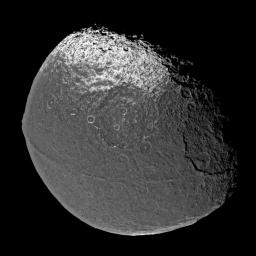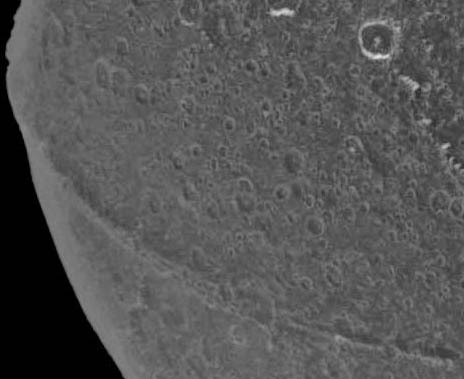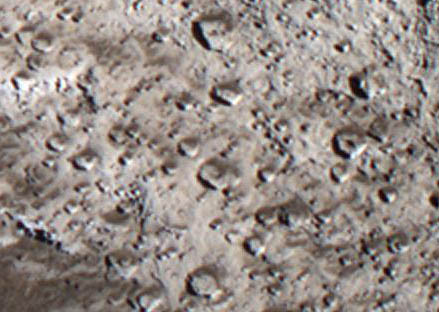The Equatorial Ridge on Iapetus
Where was I back in early January when all the other obsessives were talking about the newly discovered equatorial ridge on Saturn’s moon Iapetus? Check out this Cassini image: Encountering Iapetus:
You can also read some of the initial news coverage: Saturn’s moon reveals bulging equator.
Fortunately, I recently renewed my subscription to Sky & Telescope, one of the greatest magazines ever, so even though I missed this story when it broke, I caught it on the rebound. Turning to the Net to see what planetary scientists have come up with since the photos originally rocked their worlds back on New Year’s Eve, there’s not a whole lot. A few theories being floated around among the less-responsible types:
- It’s the remnant of an ancient ring system whose individual particles suffered orbital decay and crashed onto the moon’s surface (my money’s on this one, for what it’s worth).
- It’s the remnant of a “launch accelerator system which was once used to fire payloads into orbit around Iapetus” (gets points for style).
- It’s the seam from where the two halves of the primordial mold from which the moon was formed were joined together (heh).
It’s really too early to say, but Marshall Eubanks’ informed hunch is that the ridge and the moon’s odd light/dark bifurcation will turn out to be related: Strange equatorial feature on Iapetus. His reasoning is that it’s unlikely that the same small moon would have two weirdly anomalous global features without their being related. (Iapetus’ previous claim to fame was that the leading hemisphere — that is, the hemisphere that goes first as the tidally-locked moon orbits Saturn with the same face always facing forward — is extremely dark, while the trailing hemisphere is extremely bright.)
While they may well be related, though, I think there’s evidence in the latest images that the two features were created at different times. At least, that’s my interpretation of the following:
This is a close-up from the same image I posted, above, showing the region from the left side of the frame where the ridge reaches the moon’s limb. If you look closely, I think you can see several places where impact craters overlay the ridge, obliterating parts of it. To me, that says that the ridge predates those impacts, possibly being a relic from a time relatively early in the moon’s history.
Then there’s this close-up, which I took from another Cassini image (Dark-stained Iapetus):
This shows part of the dark-to-light transition from the area above that really big impact crater that is just above the center of the first image. It looks to me like the dark material is forming streaks “downwind” (that is, trailing off to the upper right) from some of the impact craters. This would imply (to me, at least) that the dark material was overlaid on the moon’s surface after the time when most of the impact craters were created. In other words, we could divide Iapetus’ history into at least three periods:
- An early period, during which the equatorial ridge formed.
- A middle period, during which most of the cratering occurred.
- A late period, during which the dark material was deposited.
If that’s true, then while the ridge and the dark/light appearance of the moon could still turn out to be related in some way, they didn’t come into existence at the same time, with their creations having been separated by many tens or hundreds of millions, or maybe even billions, of years.
The thing I love most about a story like this is not the way it reliably brings the kooks out of the woodwork (people like Richard “Face on Mars” Hoagland, whose Moon with a view starts with some really interesting material about Arthur C. Clarke and the history of our knowledge about Iapetus, before veering into his trademark wishful fantasizing). No, what gets me is that very real moment of shock when smart, sober, well-informed people who’ve spent their entire lives studying a subject are suddenly confronted by something they never in their wildest dreams imagined. Anyway, I look forward to getting better pictures when Cassini visits Iapetus again in 2007.




March 10th, 2005 at 5:30 am
It’s amazing…but I still can’t help wanting to shake it like a plastic easter egg to see what’s inside…
I love the new layout, btw. Very clean and fresh…
June 14th, 2005 at 6:20 am
[…] ast
Iapetus Ridge Followup
I previously talked about the weird-ass equatorial ridge on Saturn’s moon Iapetus. I’ve been wai […]
December 10th, 2012 at 2:50 am
Guys if you have not heard of the Klerksdorp Spheres then you need to check them out because it gets quite bizzare and I have made the observation elsewhere this really is a Philip K Dick world: http://www.facebook.com/photo.php?fbid=426036017438923&set=a.127835010592360.10158.127815003927694&type=1&theater
The universe is not only stranger than we imagine, it is stranger than we can imagine!
J.B.S. Haldane